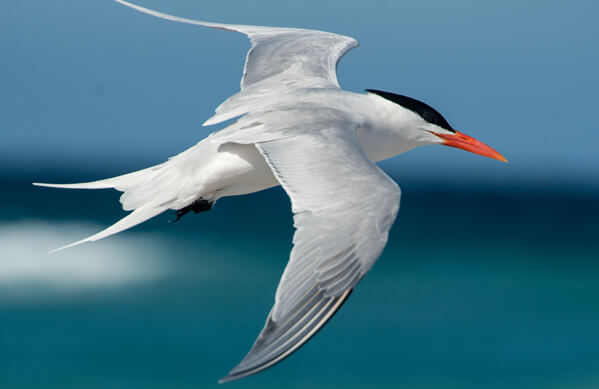 The aristocratic Royal Tern is one of the largest terns in the Americas, a noticeable step up in size from the Roseate Tern or Least Tern, for example. Distinguished from the slightly larger Caspian Tern in part by its slender orange bill and distinct call, this graceful species is a bird of ocean coastlines, rarely sighted inland.
The aristocratic Royal Tern is one of the largest terns in the Americas, a noticeable step up in size from the Roseate Tern or Least Tern, for example. Distinguished from the slightly larger Caspian Tern in part by its slender orange bill and distinct call, this graceful species is a bird of ocean coastlines, rarely sighted inland.
Tonsured Tern
During its breeding season, the Royal Tern sports a spiky, solid black cap, but for most of the year, its cap is reduced to a thin strip on the back of its head. Combined with its white forehead, the bird looks like it has a receding hairline, or a "Friar Tuck" haircut.
Like other members of its family, the Royal Tern is a social species, found in large, noisy groups. A flock of Royal Terns is known as a “highness,” well befitting its regal name. Its distinctive call is a loud, grating "keer-reet."
Listen here:
Caspian Tern for comparison:
Two subspecies of Royal Tern are recognized, one found in North and South America, the other in West Africa. American Royal Terns are further divided into two distinct populations — one in southeastern South America and one in North America, on both the Pacific and Atlantic coasts and Caribbean. North American populations migrate south to winter from the southern U.S. coasts to Peru, Uruguay, and Argentina, and the South American population is believed to winter in the same general area where it nests.
Neighborly Nester
Royal Terns pair off ahead of the nesting season. Then, a male will court a female by offering her a fish, accompanied by bowing and strutting. The pair also bows toward each other and cements bond during high, spiraling flights.
Nesting within large colonies ranging from 100 to 4,000 breeding pairs, Royal Terns often nest in mixed colonies alongside the smaller Sandwich Tern, Black Skimmer, other terns, and gulls. The Royal Tern prefers to nest on low-lying sandy islands that are isolated from potential predators. Its nest is a simple scrape on the ground that may be lined with shell fragments, fish bones, or bits of vegetation. Pairs defecate directly along their nests' rims; the waste material hardens and may help reinforce the nests against flooding, which is always a threat on low-lying islands.
Both parents incubate the single egg (there are occasionally two), which hatches at four to five weeks. Royal Tern hatchlings leave the nest scrape within a few days, joining others of their age in a large group known as a crèche. Parent birds still feed their own young, locating them in the throng by their unique calls. This "daycare" system of tending young is used by many other birds, including the King Eider, Macaroni Penguin, and Red-breasted Merganser.
Plunge-Diving for Dinner
Like other terns such as the Gull-billed Tern and the Inca Tern, the Royal Tern captures its food by plunge-diving. It flies high over the water with bill pointed down, hovers until it sights prey, then dives down to snag small fish, crabs, or squid from just below the water's surface. This tern also sometimes hunts by skimming low over the water, dipping up prey with its bill.
The Royal Tern's large size allows it to sometimes steal fish from other birds, particularly from Brown Pelicans.

Flock of wintering Royal Terns on the Florida coast by Natalya Chernyavskaya, Shutterstock
Terns in Trouble
Royal Tern populations seriously declined in the late 1800s and early 1900s, when their eggs were collected as food. Although populations made a comeback in the 20th century, new threats have arisen, particularly habitat loss as barrier islands are developed. Luckily, the Royal Tern readily accepts artificial dredge-spoil islands as alternate nesting sites.
Rising seas, erratic weather patterns, and increasingly violent storms caused by climate change also threaten low-lying nesting islands. In addition, Royal Terns are very sensitive to disturbance at their nesting colonies and may abandon them if people, dogs, or other predators approach too closely.
ABC is advocating for the Royal Tern and other waterbird species that make up Virginia's largest nesting waterbird colony. Their nesting island in the Hampton Roads harbor was paved over in late 2019 as part of a highway expansion project. We're working with partners across Virginia to secure conservation measures for this colony of up to 25,000 birds, including creation of an alternate nesting island.
If you would like to support ABC's efforts to encourage Virginia to construct a replacement nesting island, access more information here.



















































